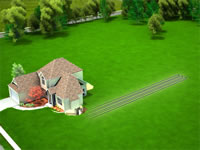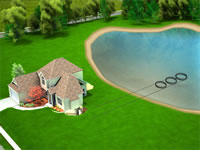The secret of a geothermal system is the earth's ability to store heat. In fact, the sun's energy that reaches our planet is absorbed into the earth. A geothermal heat pump draws heat from or moves heat into the ground or ground water, instead of the air. In the wintertime, a geothermal heat pump transfers heat from the ground or ground water to provide space heating. In the summertime, the heat transfer process is reversed; The ground or groundwater absorbs heat from the living or working space and cools the air. The energy efficiency of a geothermal
system is thus heigher than that of a conventional heat pump. These are examples
of loop systems:
Horizontal Loop
- When adequate land surface is available, this loop type may be used. Pipes
are placed in trenches ranging from 100 to 400 feet in length, depending on
geothermal system needs and available space.
Open Loop
- If available, this loop type can be one of the most economical
implementations of a geothermal system. Groundwater from a well on the
property is used as a direct energy source.
Pond Loop
- If a large body of water is available nearby, this type of system is very
economical. Coils of pipe are placed on the bottom of the nearby pond or lake
to harness the geothermal energy present.
Vertical Loop
- When available land surface is limited, this loop is the ideal choice. For
this type of loop, well drilling equipment bores small-diameter holes from 100
to 400 feet deep to harness the available geothermal energy.




